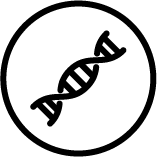
What is methylation?
Methylation is a simple biochemical process – it is the transfer of four atoms – one carbon atom and three hydrogen atoms (CH3) from one substance to another. The addition of methyl groups can affect how some molecules act in the body.
When optimal methylation occurs, it has a significant positive impact on many biochemical reactions in the body that regulate the activity of the cardiovascular, neurological, reproductive, and detoxification systems, including those relating to:

DNA Production

Estrogen Metabolism

Liver Health

Neurotransmitter Production

Eye Health

Detoxification

Fat Metabolism

Histamine Metabolism

Cellular Energy
Why is methylation important?
The body is a very complex machine, with various gears and switches that need to be all functioning properly to operate optimally. Think of methylation, and the opposite action, demethylation, as the mechanism that allows the gears to turn, and turns biological switches on and off for a host of systems in the body.
How does methylation happen?
CH3 is provided to the body through a universal methyl donor known as SAMe (S-adenosylmethionine). SAMe readily gives away its methyl group to other substances in the body, which enables the cardiovascular, neurological, reproductive, and detoxification systems to perform their functions.
Unfortunately, the system that produces SAMe is reliant on one switch being turned on by a critical B vitamin, 5-MTHF (also known as active folate or methylfolate).
Simply put, if enough 5-MTHF is present, the methylation cycle will work efficiently.
Folic acid from the diet or supplements must be converted to this active form, 5-MTHF, before it can be used in the body in the methylation cycle. Unfortunately, approximately 60% of people in the United States have a genetic mutation that makes it challenging for their bodies to create enough 5-MTHF.
When the methylation switch is turned off and isn’t creating enough SAMe, then a number of important molecules cannot be efficiently produced, including:
- Glutathione
- Coenzyme Q10
- Melatonin
- Serotonin
- Nitric Oxide
- Norepinephrine
- Epinephrine
- L-Carnitine
- Cysteine
- Taurine
The good news
First, you can have a simple and easy genetic test to find out if you have a problem with your methylation cycle. This test looks at specific enzymes that are affected by your genetic makeup, including the enzyme MTHFR (methylenetetrahydrofolate reductase), which is the most important enzyme involved in creating 5-MTHF.
Improving the methylation cycle
In addition to a healthy, whole-food, non-processed food diet, make sure you are eating a lot of these foods:
- Asparagus
- Avocado
- Broccoli
- Brussels sprouts
- Green, leafy vegetables
- Legumes (peas, beans, lentils)
- Rice
Lifestyle changes include:
- Engaging in regular physical exercise
- Avoiding excessive alcohol consumption
- Quitting smoking
- Avoiding excessive coffee consumption (not more than five cups daily)
7 essential nutrients for methylation
There are seven specific nutrients that can help the methylation cycle achieve optimal performance, even if an individual has the genetic mutation that slows down the methylation cycle.
- 5-MTHF (active folate)
- Methylcobalamin (active vitamin B12)
- Pyridoxal 5’-Phosphate (active vitamin B6)
- Riboflavin 5’-Phosphate (active vitamin B2)
- Magnesium
- Betaine (also known as trimethylglycine)
- Vitamin D
Proper methylation influences so many systems in our bodies that it often gets overlooked, which can severely impact how well your body functions. Ask your health-care provider for advice if you have any concerns about your CH3 cycle.
Not currently available.
Share:
Related Posts

Why Would I Test Positive To Foods On A Dietary Antigen Test That I Don’t Eat?
Written by Precision Point Diagnostics | 2025 True food allergies are when the body develops antibodies against a particular food, or a related food. Patients

Mitochondria: The Overlooked Link in the Gut-Brain Axis
Written by Dr Sarah Daglis | 2025 The gut-brain axis is well-established, but there’s more to this dynamic relationship than meets the eye. A vital

Unlocking Respiratory Resilience Through Functional Medicine
Article written by Dr Michelle Clark Naturopathic Doctor Clinical Education Manager, FxMed Published 1 September 2024 People take supplements to improve or optimize their health.

AHCC: Unlocking the Immune Intelligence of Shiitake Mycelia
Article written by Jessica Sanders BSc. (Psy), Dip Nat, Dip Med Herb Technical Projects, FxMed Published 1 September 2024 People take supplements to improve or

Life After Weight Loss Meds
Kathi Head, ND February 20, 2025 You would have to have been spending glorious hours lying on the beach on a desert island not to


